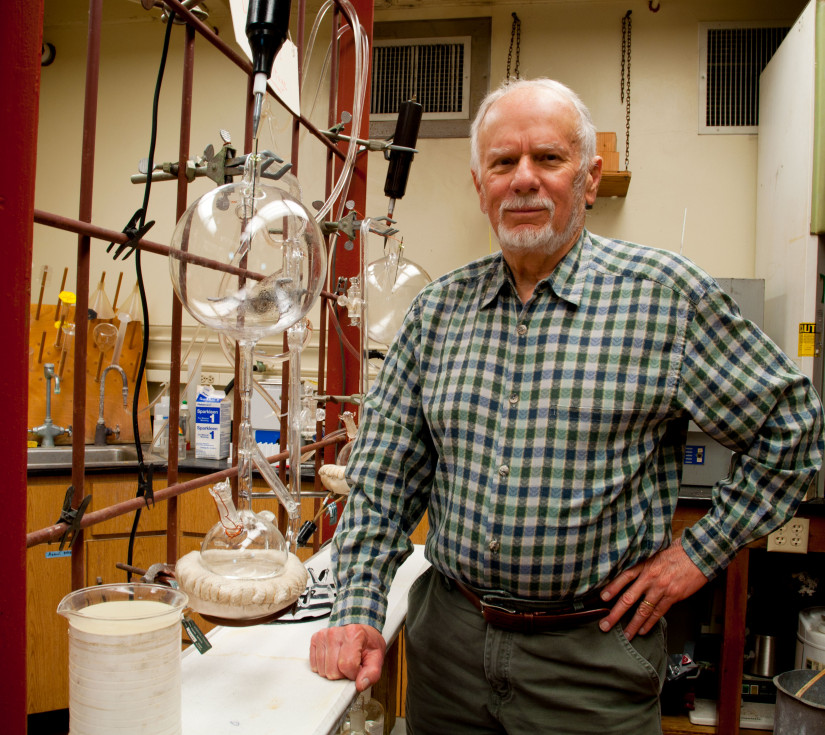The theory goes that life formed on Earth when lightning strikes created random bits of organic matter that eventually coalesced into the first living organisms.
It’s the ultimate origin story but difficult to prove since all this happened some four billion years ago. And there are other complications. A big one is that the planet was mostly covered with ice and only a very small amount of land protruded above it. That presents a problem for the established narrative because it means that the physical conditions that usually electrify clouds and produce lightning were infrequent at best.
Jeffrey Bada, an emeritus professor of marine chemistry at Scripps Institution of Oceanography at UC San Diego, proposes that volcanism could have produced the lightning bolts that charged life into existence. As magma from the planet’s interior occasionally broke through to the surface, its violent arrival would have been attended by abundant electrical energy.
“It presents a new idea and a context that hasn’t been explored so much,” Bada said.
Bada is a former student of Stanley Miller, the co-architect with Harold Urey of the famed Miller-Urey experiments that attempted to replicate the chemical conditions that gave rise to life on Earth. The experiments conducted by the two researchers – both of whom were founding members of the UC San Diego faculty when the university came into being – relied on electrical arcs generated in the lab to simulate lightning strikes. Since those experiments, conducted in the 1950s, scientists have successfully produced amino acids in re-enactments. At present, the goal of the field is to replicate what would have been the next step: the creation of RNA that would contain the information organic matter would need to replicate itself.

Bada’s hypothesis, presented in a commentary published April 10 in the journal Nature Communications, provides an explanation for how the necessary electrical energy would have been provided on early Earth. He notes that the present day provides many examples of how intense volcanic lightning can be, in particular when eruptions start underwater. In 2022, the underwater volcano Hunga Tonga–Hunga Haʻapai in the southern Pacific Ocean belched a mix of gases, ash, and seawater vapor via a 53-kilometer (33-mile)-high plume. Scientists estimate that the volatile mix of ingredients produced more than 25,000 lightning strikes, or 85 per second in a five-minute period.
Present today as well as four billion years ago are hot spots, where magma pushes through weak places in Earth’s crust to reach the surface. Such hot spots created the Hawaiian Islands among other landmasses and, as Bada notes, were probably a relatively large portion of what land there was in the planet’s first years. The mechanism of plate tectonics that formed the continents is not believed to have yet gotten started.
Bada noted that volcanic activity contributed not only lightning to the formation of life, but also pumice, the porous volcanic stone produced in eruptions. Pumice can float and indeed, a recent eruption in Indonesia produced a raft of pumice measuring nearly 100 kilometers (62 miles) in length that drifted across entire ocean basins. Such rafts would have transported the organic compounds produced in the volcanic island lightning events across vast areas of the oceans, where they could have washed up on nascent continents, seeding them with the ingredients of life.
About Scripps Oceanography
Scripps Institution of Oceanography at the University of California San Diego is one of the world’s most important centers for global earth science research and education. In its second century of discovery, Scripps scientists work to understand and protect the planet, and investigate our oceans, Earth, and atmosphere to find solutions to our greatest environmental challenges. Scripps offers unparalleled education and training for the next generation of scientific and environmental leaders through its undergraduate, master’s and doctoral programs. The institution also operates a fleet of four oceanographic research vessels, and is home to Birch Aquarium at Scripps, the public exploration center that welcomes 500,000 visitors each year.
About UC San Diego
At the University of California San Diego, we embrace a culture of exploration and experimentation. Established in 1960, UC San Diego has been shaped by exceptional scholars who aren’t afraid to look deeper, challenge expectations and redefine conventional wisdom. As one of the top 15 research universities in the world, we are driving innovation and change to advance society, propel economic growth and make our world a better place. Learn more at ucsd.edu.



